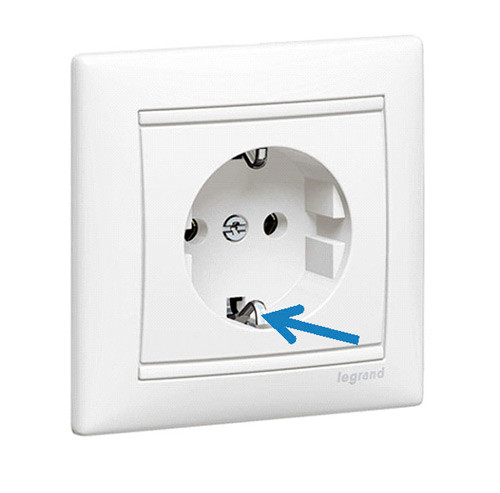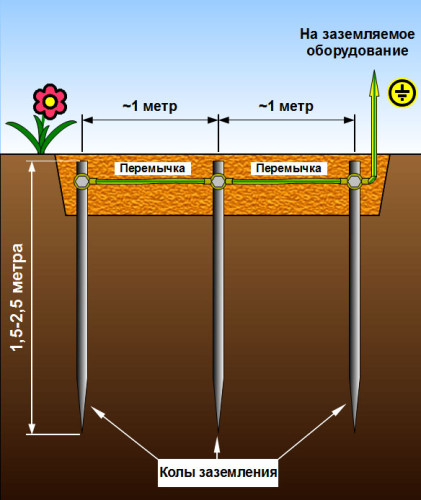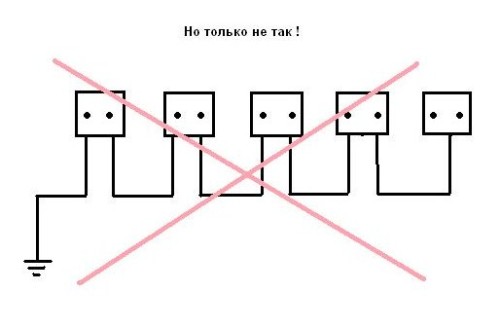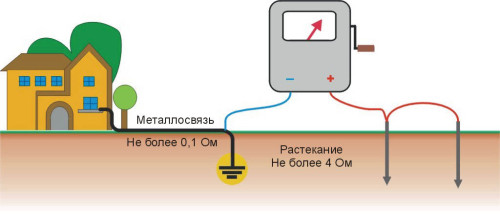
Grounding in a private house do it yourself Useful advice
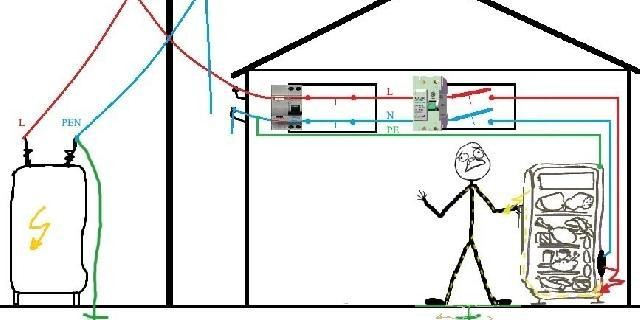
Grounding in a private house will prevent human defeat with electric shock in case of disruption of the integrity of isolation and the sample on the body of the household appliance. Next, the article will set out information about the rules for mounting the protective ground. The material will be useful for those who plan to mount grounding in a private house with their own hands.
Content
- What is the difference between the protective grounding from the worker
- Grounding of a private house: Cable and tire laying scheme
- Earth contour in a private house with your own hands: Preparation for work
- How to make grounding in a private house: phased instruction
- How to make grounding in a private house without violations
- Installation of a pin grounding system
- Control checking grounding
What is the difference between the protective grounding from the worker
The working ground is necessary to ensure the proper operation of industrial equipment and therefore, in the conditions of a private house, it does not apply.
The protective earth is consigned to the compulsory compound of metal buildings of household electrical appliances with Earth. Usually, for this, it is enough to install euro drafts with a grounding terminal, but some technique must be grounded.
List of household appliances, grounding of which is necessary.
- Washing machine: It is installed indoors with high humidity, and its body has a significant electrical capacity. Such technique must be grounded.
- Microwave: The main part of this device is a powerful magnetron. Contact violation in the outlet may cause an increase in electromagnetic radiation to hazardous values. Many manufacturers have provided protection from this: the rear panel is a terminal for additional grounding.
- Computer: Pulse power supply of this device is often a source of voltage on the housing. It is dangerous for life, as well as for the normal operation of most programs. Grounding the computer is performed by connecting the grounding wire to any screw on the housing.
- Boiler: In the process of heat heating through the diagram, a high current flows. In case of leakage on the body, a danger is created for a person, as the boiler is often installed indoors with high humidity.
- The electric oven and the cooking surface is dangerous in that the insulation of their internal wiring is strongly heated, as a result of which the probability of breakdown on the body increases.
Grounding of a private house: Cable and tire laying scheme
You must select the optimal scheme from the two most popular methods of the device of the protective ground.
- In the form of a triangle (closed circuit): such a system is of greater reliability. Damage to any part of the contour will not worsen grounding.

- The linear connection of grounding pins is dangerous in that when the integrity of the first jumper is disturbed, the entire system ceases to perform its function.
If the area of \u200b\u200bthe site allows you to install a closed earth contour, this method should be preferred to the rest. Variants of closed systems: rectangular, square, in the form of an ellipse.
Earth contour in a private house with your own hands: Preparation for work
Before proceeding with the work, you should take care of the presence of the necessary tool. To mount a grounding circuit, you will need:
- shovel bayonet;
- sledgehammer 10 kg;
- perforator;
- angle grinder;
- welding machine;
- wheel keys.
Materials for grounding:
- pipe steel with a diameter of at least 32 mm (wall thickness is 3.5 mm) or a corner of 50 × 50 mm or a similar section profile;
- the metal bus is 40 mm wide, 4-5 mm thick in the amount required for the manufacture of three sections of a length of 1200 mm and a length of length sufficient to connect the vertex of the contour with a single-core insulated wire at the wall of the house;
- m10 bolt with nuts and washers;
- copper wire, isolated, cross section of at least 6 mm².
How to make grounding in a private house: phased instruction
The right grounding of a private house should be such that the resulting potential surface is formed. The length of the side of the triangle should not be greater than 1.2 m. Otherwise, the effective area of \u200b\u200bcontact with the soil will be significantly reduced.
Mounting the grounding circuit technology provides several steps.
- The choice of space for the grounding circuit is carried out on the principle of maximum removal from the frequent stay of people. During the operation of the protective grounding, there is an electric current on the surface of the Earth, which is dangerous for life. There may be a territory along the fence, on the flower bed and near the foundation. If possible, the danger zone should be protected.
- At the stage of earthworks, the trench in the form of a triangle, as well as towards the wall of the house. Trench depth - 0.5-0.7 m.
- In the vertices of the triangle (if just such a scheme is selected) a sledgehammer into the ground drives down the electrodes to a depth of 2 m. In order for the metal easier to enter the ground, the ends of the electrodes are recommended to sharpen. On the surface there should be about 5 cm of metal for welding with a connecting bus. After connecting all vertices with welding, a metal frame is formed.

- Grounding in a private house (photo for clarity below) will last long if the welding places are protected by waterproofing material (paint, covered with bitumen mastic).
- A bus is welded to one of the vertices of the triangle and paired towards the foundation of the house. It is connected to an isolated copper wire with a screw, washers and nuts. The wire with a cross section of at least 6 mm² with isolation of yellow-green color should leave the billboard.
- Trenches fall asleep soil, which should be sealing. The flooded soil should not contain a large rubble and pieces of broken bricks. It must be homogeneous and dense.
IMPORTANT: near the foundation of the tire of the grounding circuit should have a compensation bending that prevents the metal break in the soil moves.
How to make grounding in a private house without violations
Regulatory documents (PUE, clause 1.7.110) contain the following list of prohibitions that need to be considered when installing grounding.
- Unacceptable grounding of household appliances on engineering communications pipelines (water supply, gas, heating, sewage).
- It is forbidden to perform the connection of grounding wires outside, as well as attach them to the coated oxide film or the paint pad.
- The sequential connection of grounding wiring electrical equipment is also not allowed: in case of breakdown on the body, there are interference in the other.
It should be borne in mind that grounding in a private house (220V or 380V) in the air input involves the additional attachment of the zero conductor to the contour.
Installation of a pin grounding system
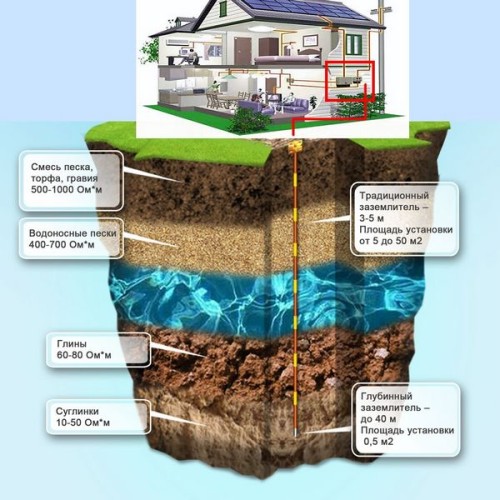
Alternative to the contour grounding system is pinching (modular). The advantage of her in the following:
- installation can be carried out on a very limited area and even in the basement of the house;
- the need for land practically disappears, energy consumption is reduced;
- work can be performed using a perforator, the welding machine is not applied;
- the service life of the grounding is much larger than the contour system.
Mounting technology consists in clogging by a perforator of modules connected to each other (as the soil deposit) with the help of special couplings or sections. To protect against corrosion, a waterproofing tape is pasted on top of the numbers. The depth of the pulmonary grounding is about 40 m (depends on the features of the soil). Works stop if the measurement of grounding resistance has shown the desired result.
The disadvantage of the pin system is its high cost: installation modules are used for installation.
Control checking grounding
How to make grounding in a private house yourself, it is already clear. But how to make sure that everything is done correctly?
It is more correct to measure the resistance of current spreading with a megommeter - an electric-inductive manual instrument. The measured resistance value should not exceed 4 Ohm.
The measurement process is carried out as follows.
- Free from the soil and clean the metallary connecting the electrodes of the contour earthing.
- At a distance of 12-15 m from the edge of the entrance to the ground (to a depth of about 1 m), two measuring electrodes that are part of the instrument. They must be clean, with a terrible surface. The distance between the electrodes is 1.5 m.
- Collect the scheme as shown in the figure below. It is important to observe the polarity during the connection of the elements of the scheme to the megommeter: the wire from the measuring electrodes is joined to the "positive" terminal of the device, from the contour to the "minus". The measurement range switch (if any) is translated into the "Ohm" position.
- Conduct measurements. In the event that the results exceed the value of 4 ohms - revise the entire system, correct errors.
In the absence of a megommeter or another special device, you can use a simpler method for checking the quality of the installation of protective grounding. To do this, be connected to the phase wire (terminal) of the power grid one of the contacts of the incandescent bulb with a capacity of 100 W. Another contact of the bulb - to the metalliament of the grounding. If the light is burning brightly - the grounding was performed correctly. Dull light will indicate bad contacts of the system. The lack of light means a break in the grounding scheme that you want to eliminate.
In conclusion - grounding in a private house: video demonstrating the installation process with a specialist comments.




